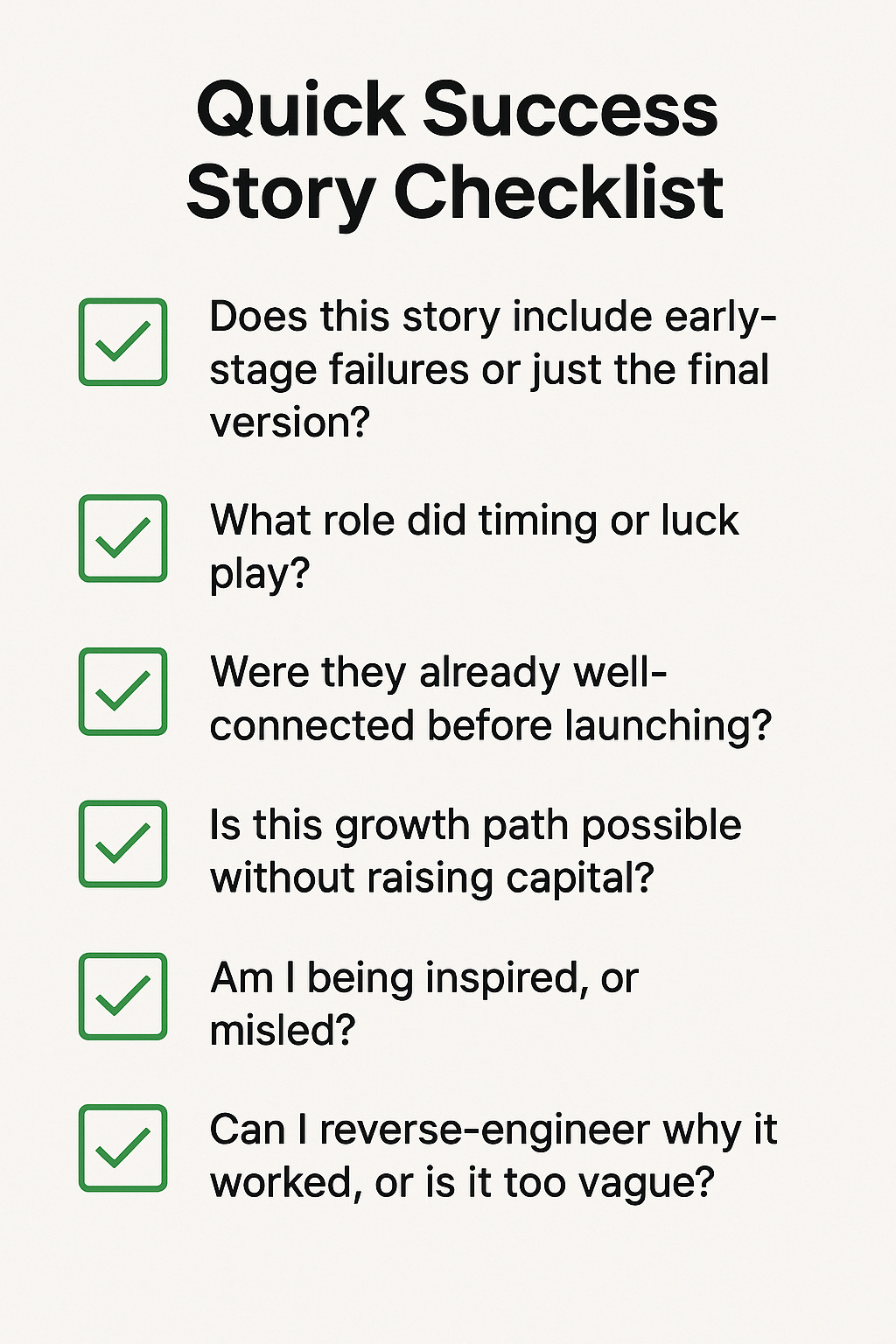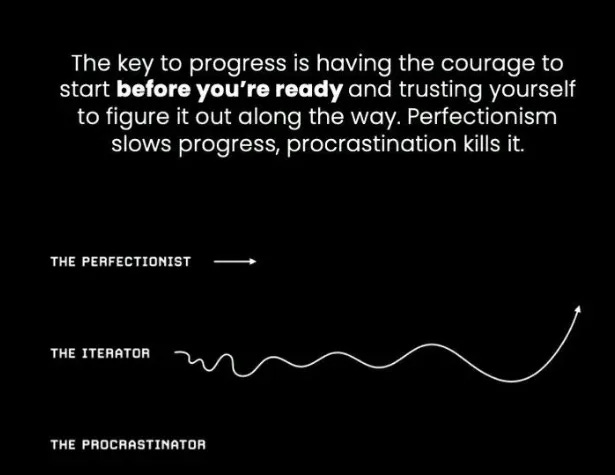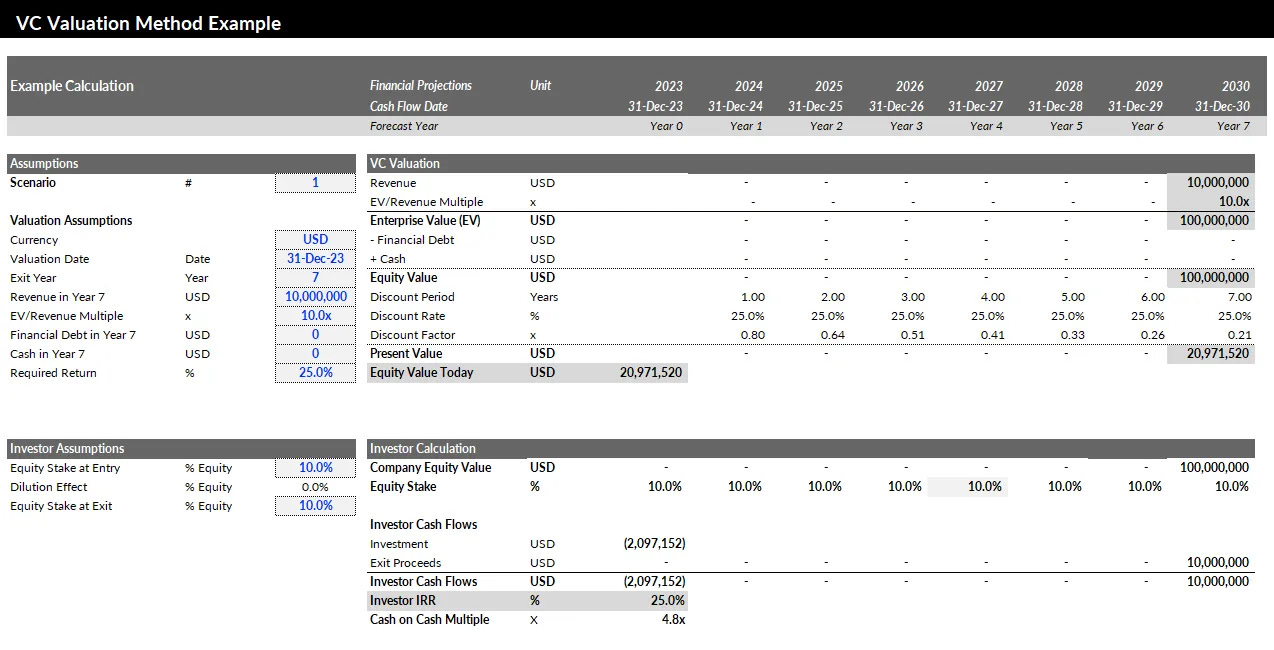Survivorship Bias Is Killing Founders' Judgment—Here’s the Fix
Startup success stories sound inspiring, but they can quietly wreck your judgment
Why Startup Lessons from Success Stories Can Be Misleading
You’ve heard the stories.
The founder who maxed out their credit cards, slept on the floor, and 18 months later raised $20M from a top-tier VC.
It’s inspiring. But also misleading.
Because for every story like that, there are hundreds of others you never hear about. Founders who worked just as hard but never made it. Wrong market. Wrong timing. No lucky break.
We celebrate survivors and forget the rest. That creates a dangerous illusion: that startup success follows a pattern, and if you just copy the steps, you’ll get the same outcome.
Before we dive deeper...
Brought to you by Attio: The powerful CRM loved by teams
Startups close deals with it. VCs track pipelines with it.
I use Attio to run everything from founder convos to team ops. Zero setup, total flexibility.
It’s also AI-native and adapts to you. Auto-route leads, surface insights, and power smarter workflows – whatever you need for your GTM engine.
Used by Flatfile, Replicate, Modal, and more.
Back to the real story:
Most startup advice is backward-looking. It turns messy, uncertain decisions into clean post-hoc logic. The result? Founders chasing playbooks that worked for someone else, at a different time, in a different market.
The reality is far messier.
Even successful startups screw up early. They pivot, stall, run out of cash, lose key hires. But those parts don’t make it into TechCrunch. They don’t go viral.
And that’s the problem.
If you're a founder trying to learn from others, the loudest voices might be the most misleading. The best insights often come from the quiet stories — the ones that didn’t go viral.
And that’s what this article is about.
Table of Contents
Startup Lessons Worth Learning (That Success Stories Ignore)
Why Startup Failure Lessons Matter More
Common Myths Success Stories Spread
Startup Lessons from Founders Who Failed First
What to Ask When Reading a Startup Success Story
Key Takeaways for Founders on Startup Lessons
FAQs About Startup Lessons
1. Startup Lessons Worth Learning (That Success Stories Ignore)
Some of the most valuable startup lessons never make it into pitch decks or press stories. They happen behind the scenes; when a launch flops, when a co-founder walks away, when a user churns for the fifth time in a row.
These moments don’t trend on social media. But they shape the kind of founder who can actually build something that lasts.
Success stories are often retrofitted. They leave out the stalls, the pivots, the rewrites. If you want real startup lessons, you have to go looking for what the glossy posts ignore.
Real Startup Lessons from Failure
Failure doesn’t mean the founder got it wrong. It often means they were early, off-track, or not honest enough with themselves.
VReal was a VR startup that raised $15M and shut down because consumer VR just wasn’t ready. Their founder admitted they “bet on the future arriving faster than it did.” That’s not bad execution, it’s mistiming, one of the top reasons for startup failure.
Nup was a social calendar app that launched with big design ambitions but failed to solve a painful enough problem. In their breakdown, the founder reflects that “nobody needed it, so nobody came back.” They learned to prioritize user problems, not features.
The startup lessons here are clear:
Product–market fit isn’t optional.
Emotional resilience matters more than investor validation.
The timeline to traction is longer than you think.
These stories don’t go viral. But they teach founders how to survive the gap between vision and reality.
The Importance of Iteration Over Perfection
We celebrate clarity in hindsight. But most great startups stumbled into their eventual form.
Slack started as an internal communication tool inside a failed gaming company.
Instagram began as a Foursquare competitor called Burbn, until the founders stripped it down to the only feature people liked - photo sharing.
These companies didn’t get it right the first time. They shipped, learned, and pivoted.
And that’s the core startup lesson here - iteration beats perfection.
As executive coach Jerry Colonna puts it in his interview with Every.to, perfectionism often masks fear. Founders delay launches because they’re scared the market won’t love what they built. But until you ship, you’re not in the game.
Polished success stories rarely show the version 1.0 that tanked. They fast-forward to the version that worked. What you don’t see are the five pivots, the dozens of quiet tests, the Google Docs duct-taped into a prototype.
The startups that survive are the ones that get something live, stay close to users, and adjust, over and over again.
2. Why Startup Failure Lessons Matter More
Success gets the spotlight, but failure teaches the playbook. For every startup that scales, there are dozens that quietly shut down, pivot, or fade out. And while success stories can be inspiring, they often hide the edge cases - the lucky breaks, the timing, the network advantages.
Startup failure lessons, on the other hand, are grounded in what actually went wrong. They’re specific. They’re honest. And they’re repeatable.
Founders who study failure learn to spot patterns that aren’t visible in polished narratives. They see how small mistakes compound. How mismatched teams implode. How misreading the market early can drain months of runway. These lessons don’t just build awareness. They sharpen judgment.
In Silicon Valley and other startup hubs, failure isn’t a scarlet letter. It’s often seen as a sign you’ve been in the arena. Investors know that founders who’ve failed, thoughtfully, bring battle scars that lead to sharper execution next time.

Why You Should Study the 90% Who Don’t Make It
According to the 2024 Global Startup Ecosystem Report, only about 1 in 12 startups raise a Series A. And fewer than 10% of funded startups go on to make a significant exit. The rest either pivot, stall, or shut down quietly.
That’s the silent majority, and they’re full of lessons.
In a research that analyzed over 150 startup breakdowns, the most cited reasons for failure weren’t exotic, they were painfully familiar:
Poor market timing
Hiring the wrong team
Weak marketing strategy
Misaligned founder dynamics
Running out of cash due to preventable overspend
These aren’t just red flags. They’re recurring patterns. And by studying them, founders can avoid making the same mistakes in their own journey.
The key insight is that failure is far more consistent than success. And that makes it a better teacher. Learning from startup failure isn’t about dwelling on mistakes. It’s about pattern recognition. It’s about developing the instincts that help you survive the parts of the startup journey no one brags about.
3. Common Myths Success Stories Spread
Startup success stories are often designed to inspire. But in doing so, they also tend to oversimplify. The danger isn’t just that these stories skip over the messy middle. It’s that they reinforce startup myths that can quietly lead new founders down the wrong path toward overspending, burnout, or chasing the wrong goals altogether.
Let’s unpack some of the most persistent myths, and the startup lessons that actually hold up under pressure.
👎 Myth: You Need to Raise VC to Win
One of the most damaging startup myths is that venture capital is the only path to success. Founders see big funding rounds splashed across headlines and start to believe that raising is the milestone that validates a business.
But the truth is that many successful companies grow through bootstrapping, slow revenue, or customer-funded models. Raising VC can be a growth accelerator, but it also comes with dilution, pressure, and a very specific growth mandate. If you’re not building a venture-scale business, raising money might actually increase your risk of failure.
Plenty of founders who skip VC build solid, profitable businesses. It’s just that those stories don’t get press. But they do exist, and they’re often more sustainable.
👎 Myth: Timing Doesn’t Matter
Founders love to believe that hustle can overcome anything. But timing can kill a great product, and no amount of grind can change that.
Some of the most spectacular startup failures had great ideas, but launched too early or too late. Think of Friendster (too early for mass social networking) or Quibi (too late for mobile-first video consumption).
Success stories rarely highlight timing. They frame success as a result of strategy or brilliance. But in many cases, being just a year too early or late makes all the difference.
👎 Myth: Hustle Culture = Success
The idea that startup success is all about grind, hustle, and 18-hour days is one of the most harmful startup myths out there. It's a mindset that leads to burnout, not better businesses.
Founders see Twitter threads about “sleeping in the office” or “never taking days off” and think that’s what it takes to win. But the best startup advice from real operators often centers around sustainable energy, emotional regulation, and smart delegation.
Great businesses aren’t built on burnout. They’re built on consistency, clear thinking, and endurance.
👎 Myth: Big Launch = Big Growth
Thanks to media coverage and founder storytelling, many believe that a big launch guarantees traction. The truth is, most launches are soft and slow, and that's okay.
Rarely do startups explode overnight. Even so-called “overnight successes” have often been testing and iterating for years before they go public. What matters more than the launch is what happens afterward, how fast you learn, how well you onboard users, and how you refine your offer.
A flashy debut without a strong retention loop is just noise.
How These Myths Distort Reality
These startup myths may seem harmless, but they add up. They create false expectations. Founders who believe they must raise VC might ignore profitable growth paths. Those who glorify hustle may neglect their health or their team’s. And chasing a perfect launch could delay the feedback they need to iterate and grow.
Worse, these myths create shame. When your journey doesn’t match the script, you start to wonder if you’re failing, when really, you’re just experiencing what most founders do.
The best startup advice is to question the myths. Learn from actual stories, not just the ones designed to go viral.
4. Startup Lessons from Founders Who Failed First
Some of the most respected founders today didn’t strike gold on their first try. In fact, many of them failed - publicly, painfully, and sometimes repeatedly - before building the companies they’re known for.
What separates them isn’t just resilience. It’s reflection. They treated failure like a training ground. And the startup lessons they carried into their next ventures often became the difference between collapse and compound growth.
Let’s look at a few founder stories that prove failure is rarely the end, just a messy beginning.

Stewart Butterfield – From a Failed Game to a Workplace Giant
Before Slack, Stewart Butterfield was building a multiplayer game called Glitch through his company Tiny Speck. Despite raising millions and attracting attention, Glitch failed to find traction. The game was shut down, but in the process, the team had built an internal communication tool to collaborate remotely.
That tool became Slack.
Lesson learned: Butterfield didn’t cling to the original vision. When Glitch failed, he pivoted with brutal honesty and doubled down on the one thing that had real engagement. Slack’s success came from following usage patterns, not investor hype.
Melanie Perkins – Rejection, Refinement, and Canva
Before founding Canva, Melanie Perkins spent years building Fusion Books, a yearbook-design platform in Australia. While the product worked, growth was slow, and the niche was limiting.
When she began pitching Canva, she was rejected by over 100 investors. Most said the idea was too ambitious.
Perkins kept refining. She narrowed her pitch, tightened the UX, and slowly assembled a world-class team, including a co-founder with deep tech and financial expertise. Today, Canva is valued at over $25 billion.
Lesson learned: Perkins shifted from niche to global by simplifying her value proposition and obsessing over usability. She also learned to be patient with capital, raising money only when the foundations were ready.
How VCs Value Startups: The VC Method + Excel Template
"Wondering how venture capitalists decide your startup’s valuation?" This guide breaks down the proven Venture Capital Method — and includes a Excel model to help you run your own numbers.
Evan Williams – Missed Before He Hit
Long before Twitter, Evan Williams co-founded Odeo, a podcasting platform that was completely blindsided when Apple launched iTunes podcast support.
Odeo was rendered obsolete overnight. But instead of sinking the ship, Williams gathered the team and asked what else they could build. That internal brainstorm became Twitter.
Lesson learned: Williams understood when to stop. He didn’t try to salvage a broken model. He shifted focus and gave his team room to experiment. The second time around, he let traction lead the strategy.
What They Did Differently the Second Time
These founder stories aren’t outliers. They’re blueprints.
Here’s what each of them adjusted after their first venture failed:
✅ Market Validation: They listened to real user behavior, not assumptions. Slack and Twitter both emerged from internal usage, not grand visions.
✅ Team Composition: They got clearer on who they needed around them. Canva only took off when Perkins brought in technical and commercial partners who could execute.
✅ Capital Discipline: They raised VC at the right time, not to look impressive, but to scale what was already working.
✅ Mental Flexibility: Perhaps most importantly, they dropped ego. They pivoted. They built based on the signal, not stubbornness.
These aren’t feel-good stories. They’re earned startup lessons learned through missteps, hard pivots, and deliberate change.
5. What to Ask When Reading a Startup Success Story
Startup case studies can be inspiring. But if you take them at face value, you risk learning the wrong lessons. Most success stories are shaped in hindsight. They focus on outcomes, not context. And they often leave out the uncomfortable truths, like how much luck, privilege, or pivoting was involved.
If you're serious about learning from other founders, you need to read these stories with a critical lens. The startup learning curve isn’t a highlight reel. It’s made of slow traction, hidden struggles, and behind-the-scenes decisions that rarely get shared.
Here are a few questions to ask the next time you come across a too-clean success story.
What part of the story is missing?
Are they talking about failures, near-deaths, or pivots? Or just the wins?Was there luck or timing involved?
Did they benefit from a new platform trend, macro shift, or first-mover advantage?What resources or network advantages did they have?
Friends at top VC firms? A well-known alma mater? Personal capital or safety nets?Would this strategy work for someone with zero funding?
Or did their burn rate only make sense because of a seed round?Is the model scalable, or just successful for them?
Does their growth path apply broadly, or is it a niche case?
Founders who learn fast often share one habit - they question what others take for granted. That includes success stories.
A Quick Success Story Checklist for Founders
Use this mental checklist the next time you scroll past a viral launch thread or podcast feature.

Startup case studies aren’t bad. But they’re not blueprints. The best founders extract principles, not just praise. If the story doesn’t hold up to these questions, it might not be worth modeling.
6. Key Takeaways for Founders on Startup Lessons
If you’re building a startup, there’s nothing wrong with reading success stories. They can be energizing, even instructional. But if you take them too literally, they can quietly distort your expectations. What’s shared publicly is often polished, selective, and heavily shaped by hindsight.
The real startup lessons, the ones that actually help you grow, usually come from the stories no one’s telling - the pivots, the stumbles, the quiet rebuilds after things went sideways. This is where founders sharpen their instincts and earn their judgment.
To navigate the startup learning curve, you need both sides of the story - the inspiration and the reality. But you also need to know when to question the script.
Here’s what to take with you:
Success stories are incomplete. They often omit the struggles, timing, and luck that shaped the outcome.
Failure teaches depth. The sharpest insights often come from the ventures that didn’t work.
Learn from both, but question everything. The real edge is knowing how to filter the signal from the noise.
Startup lessons for founders don’t come in a one-size-fits-all package. The most important thing you can do is stay curious, stay skeptical, and keep learning, especially when things aren’t working yet.
7. FAQs About Startup Lessons
Are startup success stories reliable sources of advice?
They can be, but read them critically. Most success stories highlight outcomes, not the messy path that led there. They’re often shaped by survivorship bias and hindsight. Use them for inspiration, but don’t treat them as blueprints. Always ask - what’s missing from the story?
What are the most common startup lessons first-time founders miss?
Many first-time founders underestimate how long things take, how crucial product–market fit is, and how hard hiring the right team can be. They also miss the value of iteration and feedback. Success isn’t linear, and learning fast from mistakes is more useful than chasing perfection.
Why do failure stories teach better startup lessons than success stories?
Failure stories are honest by necessity. They reveal what didn’t work, where assumptions broke down, and what founders would do differently. These startup failure lessons offer grounded insights that apply to real-world challenges, unlike success stories, which often skip over the details that truly matter.
How do I evaluate if a startup success story is relevant to me?
Ask yourself - Did this founder have access to capital or networks I don’t? Is their strategy replicable with my resources? Is the market timing still valid? If their path depends on variables you don’t have, their story may inspire, but it shouldn’t guide your decisions.
Can copying a successful startup model work for me?
Sometimes, but context matters. Market conditions, timing, execution, and founder experience all play a role. Copying a model without understanding why it worked can backfire. It’s better to extract principles than mimic playbooks. What worked for them won’t automatically work for you.
Should I still read startup success stories?
Absolutely! But read them like a detective, not a fan. Look for what’s left out. Analyze the early steps, not just the outcome. Pair them with failure stories and real case studies. When balanced with critical thinking, they can motivate and educate.
Wait! Check out the following resources 👇
✅ SaaS Financial Model
✅ Cap Table at Series A & B
✅ The Startup MIS Template: A Excel Dashboard to Track Your Key Metrics
✅ The Go-To Pricing Guide for Early-Stage Founders + Toolkit
✅ DCF Valuation Method Template: A Practical Guide for Founders
✅ How Much Are Your Startup Stock Options Really Worth? Startups
✅ How VCs Value Startups: The VC Method + Excel Template
✅ 2,500+ Angel Investors Backing AI & SaaS Startups
✅ Cap Table Mastery: How to Manage Startup Equity from Seed to Series C
✅ 300+ VCs That Accept Cold Pitches — No Warm Intro Needed
✅ 50 Game-Changing AI Agent Startup Ideas for 2025
✅ 144 Family Offices That Cut Pre-Seed Checks
✅ 89 Best Startup Essays by Top VCs and Founders (Paul Graham, Naval, Altman…)
✅ The Ultimate Startup Data Room Template (VC-Ready & Founder-Proven)
✅ Ultimate Investor List of Lists (+5k VCs)
✅ The Startup Founder’s Guide to Financial Modeling (7 free templates included)
✅ SAFE Note Dilution: How to Calculate & Protect Your Equity (+ Cap Table Template)
✅ 400+ Seed VCs Backing Startups in the US & Europe
✅ The Best 23 Accelerators Worldwide for Rapid Growth (and How to Get Into Them)
✅ AI Co-Pilots Every Startup & VC Needs in Their Toolbox








"For every startup that scales, there are dozens that quietly shut down, pivot, or fade out. And while success stories can be inspiring, they often hide the edge cases - the lucky breaks, the timing, the network advantages."
This is such an important message. We feed on success stories, on hype. But these are outliers.
If we were to judge the startup success rate based on publicity, we'd guess that 80%+ of them succeed. In reality, we know the odds are the exact opposite or worse.
In fact, the stories of Slack, Canva, et al are misleading too. They are, in fact, still success stories, with but a bit more rocky paths.
The stories we don't hear are those of anonymous founders who burned through whatever 5-to-low-6-digit budget they could muster, only to fail to get enough traction to secure more funds. Or those of seed-funded products that might have even been viable, but their growth rate was utterly uninteresting for VCs, so eventually someone pulled the plug.
To paint an accurate picture, we should have a dozen of those for each *reasonably successful* startup (and I'm not talking about unicorns here, they're the outliers of the outliers).
Great article.